Localization strategy
Localization (l10n): What It Is, and How to Build a Strategy?

Localization (l10n) is the process of adapting a product to meet the cultural, linguistic, legal, and other requirements of a target market. Established global brands know it well: No matter where people are in the world, they can use services like Airbnb or Uber in their own languages and enjoy a user experience (UX) that aligns perfectly with their preferences and expectations.
To help you make the most of it, too, we’ve put together this comprehensive overview of localization—outlining what it is, why it matters, and how it works. It will also walk you through the process of creating the right localization strategy for your business—from setting clear goals and establishing a future-proof workflow to measuring your success along the way.
What is localization?
The internet has made information and a wide range of products and services universally accessible. For growing businesses, this means more selling opportunities in international markets.
At the same time, making a product relevant to potential customers in a target market has become more challenging than ever. Regardless of their location, consumers expect a seamless, personalized experience throughout the buyer journey. That’s where localization comes into play.
Localization (abbreviated as l10n) is the process of adapting products or services to the language and culture of different target markets.
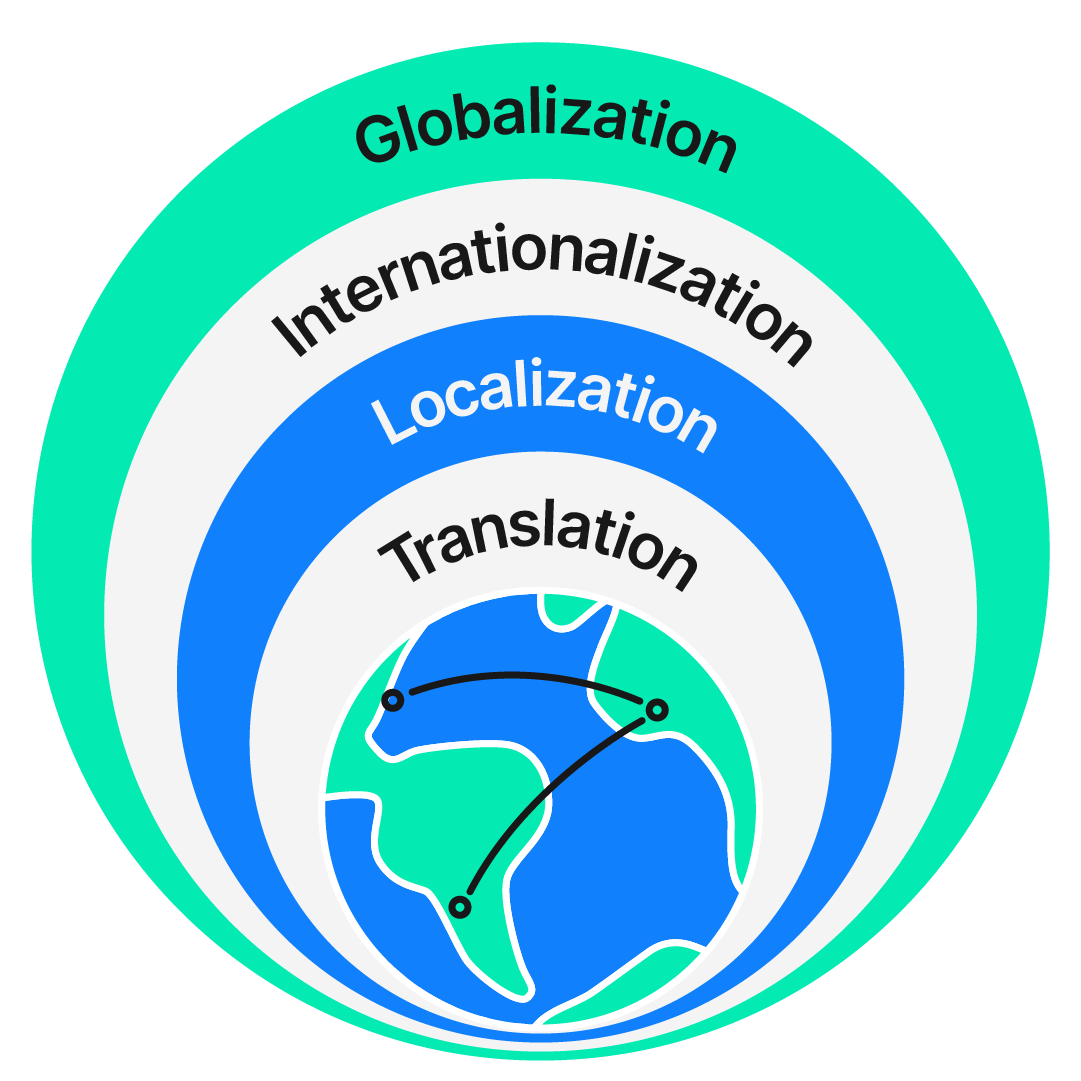
In the words of Giulia Tarditi, Head of Global Experience at Qualtrics, an experience management software provider:
Localization is the lesser-known sister of customer experience.
Take, for example, Starbucks in Japan. The global coffeehouse chain has launched the Japan Wonder Project to create interest in local Japanese culture by offering customers a casual way to enjoy unique Japanese ingredients in their everyday Starbucks beverages. The initiative underscores the company’s dedication to delivering a customer experience adapted to local preferences and customs.
View this post on Instagram
Localization is a bold undertaking that goes beyond the mere translation of text. It includes modifying a range of aspects to the local context of a target market:
- Product features
- Images and graphics
- Cultural references (symbols, icons, idioms, etc.)
- Date and time formats
- Pricing, currency, and payment methods
- Measurement units
- Legal and regulatory compliance
- Branding and messaging
- Marketing content (blog posts, landing pages, etc.)
- Promotional channels (search engines, social media, paid ads, etc.)
- Help content and customer support channels (knowledge bases, chatbots, etc.)
| The why, how, and what of localization in brief | |
| Why | Localization is driven by the belief that human connection transcends borders—aiming to foster universal communication by building trust and loyalty. |
| How | Localization achieves its purpose through thoughtful adaptation—embracing cultural sensitivity, linguistic expertise, and respect for local nuances. |
| What | Localization tailors products, services, and content—aligning everything from look and feel to messaging with local norms, preferences, and expectations. |
Why language localization matters for global business
Expanding internationally is like discovering a captivating treasure trove of opportunities. With a broader customer base, your business can embark on exciting new journeys.
Still, despite the enticing promise, some businesses hesitate to embrace the adventure because of perceived risks and complexities. For example, they have concerns that localizing a product or service might result in increased administrative overhead and slower release cycles. Consequently, they may question whether it’s worth investing time and resources.
While there’s always a cost to doing business, aiming to expand your global reach leaves little room to sidestep localization. To justify an investment, consider this brief overview of why localization is important in international business:
Localization facilitates market entry
Launching your product or service in international markets brings its own set of challenges. On top of legal and logistical obstacles, cultural and communication issues may be serious roadblocks.
While localization can’t eliminate all of these speed bumps, it can help you avoid potential cultural faux pas through bad translations or inappropriate images that could damage your brand.
By addressing cultural nuances and language preferences from the start, you reduce the time it takes for potential customers to connect with your offering, ultimately helping your business gain traction more quickly.
Dolce & Gabbana’s controversial ad campaign in China—a missed opportunity for localization
In 2018, Dolce & Gabbana faced enormous backlash after a series of short ads were released in China stereotyping Chinese people.
The controversial ads featured a Chinese model dressed in a lavish Dolce & Gabbana dress trying to eat pizza with chopsticks while a male voiceover condescendingly gives her instructions to be able to eat.
The ads were met with outrage by some members of the Chinese community. A Weibo (Chinese social network) user commented: “That’s explicit racism.” There were even calls to boycott the brand.
With Chinese consumers making up a third of the global luxury market, Dolce & Gabbana seems to have completely missed the mark with these ads. A localization strategy that took cultural sensitivities into account would have helped them avoid this pitfall.
Localization provides a competitive edge
When facing local competitors in a new target market, it can be challenging to compete against companies that are deeply ingrained in it. Local businesses often find it easier to establish trust with their audience compared to new players.
By localizing your product, you effectively level the playing field and create a more even competitive landscape.
Similarly, on the global stage, having competitors who aren’t engaged in localization also gives you a distinct edge. This advantage allows you to establish a strong foothold in new markets.
While your rivals may struggle to navigate the complexities of catering to local preferences, your commitment to localization positions you to capture a larger share of the market and solidify your presence in regions where others might falter.
Localization improves customer satisfaction
Localizing your content will show your commitment to your customers. If you’re addressing your customer’s needs in a way they understand and are comfortable with, they’re more likely to buy your product or service.
From user manuals and payment methods to multilingual customer support, localizing all parts of the customer journey will help your customers make a buying decision much more easily.
Localization fosters brand loyalty
Delivering a seamless user experience lays the foundation for fostering trust among your buyers—a crucial element for building brand loyalty. Establishing this trust entails communicating with your users in their native languages and customizing your product to their needs.
Satisfied customers tend to develop strong brand loyalty and are inclined to remain committed, ultimately evolving into authentic advocates for your product.
Localization boosts revenue
Reaching a broader audience means greater revenue potential—and when you localize your product well, you have a good chance to see a boost.
Localization is essential for keeping current customers and acquiring new ones—both of which can impact your bottom line.
At the same time, by automating translation processes using cloud localization technology, you will be sure to make the most of your resources and stay productive.
All of this can lead to a significant localization ROI (return on investment) that can impress everyone in your organization.
On-demand webinar
Localization: Why you need it, and how to start
Learn from our expert panel how to prepare for global expansion, overcome common localization obstacles, and drive international growth.
Translation and localization: What’s the difference?
Translation and localization are often confused to be the same. As much as translation matters, rolling out a global product isn’t only about transferring an application, website, or marketing assets from one language to another.
Instead, making a product accessible to people across markets means adapting it to cultural differences, linguistic specificities, purchasing habits, legal requirements, local payment methods, and more.
The main difference between translation and localization is the following:
-
Translation is the transfer of text from one language (the source) to another (the target). The goal is to accurately reflect the meaning and purpose of the original.
-
Localization is the process of adapting translations to the culture of a target market so that they look and feel as native as possible.
Here are a few considerations to remember during localization to make sure your product or service works well in the local context of your customers:
Slang, idioms, colloquialisms
Slang words carry much more than just the concepts they describe. They often reveal a lot about the speaker’s social background, age, and even their mood. Simply replacing them with their dictionary equivalents might not only sound unnatural but also fail to deliver the message as intended.
Imagine a brand whose entire messaging is based around American youth slang. Directly translating funny little words such as “on fleek” or “lit” into other languages would be a surefire way to lose the company’s target audience in other markets. Instead, you need to carefully research the local equivalents of such words and expressions to make sure your message still hits home.
Slogans
Slogans are another great example of how localization can go beyond translation. A slogan that works in one market might not only sound odd but also be completely meaningless in another. This is because slogans often rely on wordplay, puns, or other linguistic specificities that don’t translate well (or at all).
Take “I’m loving it.” The non-standard grammar of this iconic McDonald’s slogan would be completely lost in languages where “present continuous” is not a thing. If it meant and sounded just the same as “I love it,” it would be nowhere near as effective.
Symbols, icons, and colors
Colors are often loaded with cultural meanings that don’t necessarily translate well to other cultures. For example, white is the color of purity in Western cultures but death and mourning in Eastern ones.
The same goes for symbols and icons: The common Western sign for “okay” (👌)has a vulgar meaning in Arabic cultures. An even more amazing example, the “slightly smiling” emoji (🙂) is actually a sign of disbelief in China.
Imagery
Images are another highly culturally influenced element. A picture that works in one market might not only look odd but also be completely meaningless in another. This is because images often rely on cultural specificities that don’t translate well (or at all).
For example, the picture of a Christmas tree on a Christmas card would be lost in cultures where Christmas is not a thing. Depending on the context, it might even be seen as offensive.
Text length and direction
Localization also involves technical aspects that go beyond translation. For example, text length and direction are two things that need consideration when localizing a website or an application.
Some languages, such as German, are much longer than English. So if your designer’s approach is to cram as much text as possible into every nook and cranny of the UI, you might end up with too little space for the translated text.
The same goes for text direction: Right-to-left languages such as Arabic or Hebrew need to be taken into account when designing the UI. This means, first of all, that you should internationalize libraries, fonts, and tools that support them.
Currency, number, date, and time formats
Other technical aspects of localization that go beyond translation are currency as well as number, date, and time formats.
Different countries use different currencies, so you need to make sure your product or service can handle them all. The same goes for date formats: In the US, people write dates in the M/DD/YYYY format (e.g., 3/14/2015), while in other countries, DD/MM/YYYY (e.g., 14/03/2015) is the norm.
The list goes on for time, numbers, and even phone numbers. So if you’re planning to expand your business globally, make sure your product can handle all the different formats.
Legal requirements
Last but not least, there are also legal requirements that can differ from one country to another and which you need to consider during localization. For example, different countries have different laws and regulations regarding terms and conditions, privacy policies, cookies, and so on.
In the European Union, for example, the General Data Protection Regulation (GDPR) requires companies to get explicit consent from users before collecting, using, or sharing their personal data. This means that if you’re planning to expand your business to the EU, you need to make sure your product or service complies with GDPR.

Compare Starbucks’ website layouts for the US and Japanese markets © Starbucks
How does localization work?
Depending on the nature of your product or service, localization takes on various forms. Let’s explore the most common ones.
Software localization
With software playing an increasingly significant role in people’s daily lives around the world, localization has become crucial for ensuring a user-friendly experience across languages and cultures.
Software localization involves adapting all UI elements, including in-app tooltips and call-to-action buttons, and other in-product copy to align with the preferences and needs of your target market. It also includes changing units of measure, date and time formats, and currencies to conform to local standards.
🗒 Tip » If your product is a mobile app, then you need to take into account further requirements to adapt it for international markets. For example, keeping all your copy up to date in all languages, without forcing users to download the app each time you release an update, is key in app localization.
Website localization
Your website is often the initial touchpoint for potential customers. If they don’t get past the homepage, they might miss your product altogether.
That’s why it’s advisable to take website localization seriously and make sure all your web pages are adapted accordingly. Again, this includes translating all content into the target language, as well as adapting images, videos, and other visual elements.

In a market as price-sensitive as Germany, Amazon’s homepage prominently features tips for saving money © Amazon
🗒 Tip » If your website features a blog or comes with multilingual landing pages, think about utilizing a plugin (such as a WordPress translation plugin for WordPress-based sites) to streamline the translation process from start to finish.
Video game localization
Game localization is the process by which a video game is adapted to the culture and language of players in a target market. It encompasses elements such as spoken dialogues and instructions, characters, game manuals, marketing assets, and many more. Game localization aims to make a video game seem as though it was made in the target language and culture.
🗒 Tip » If a given culture or language makes adapting a game difficult, the least you can aim for is high-quality translation that provides a seamless user experience for your players.
Product localization
Product localization involves customizing a product or service to meet the specific needs of a particular market. It includes adjusting features, pricing strategies, user interface elements, images, and other product elements to align with the cultural and linguistic preferences of the target audience. The goal is to create a UX that feels native and relevant to local customers.
This approach not only breaks down language barriers but also ensures that the product’s functionality, pricing, and presentation are well-suited to the market’s expectations. By doing so, businesses can increase their chances of success in new markets and build stronger customer relationships.
🗒 Tip » Ensure that all button links in your product’s UI are configured to direct users to a version of your product that is specific to their locale.
Marketing localization
Marketing localization is about more than just transferring the meaning of marketing materials between languages—it’s about understanding customer needs in your target market and adapting your message to resonate with them on an emotional level.
This includes everything from developing new taglines and slogans to creating entirely new ad campaigns specifically for the target market. In some cases, you might even need to develop a completely different brand identity that’s more in line with local preferences.
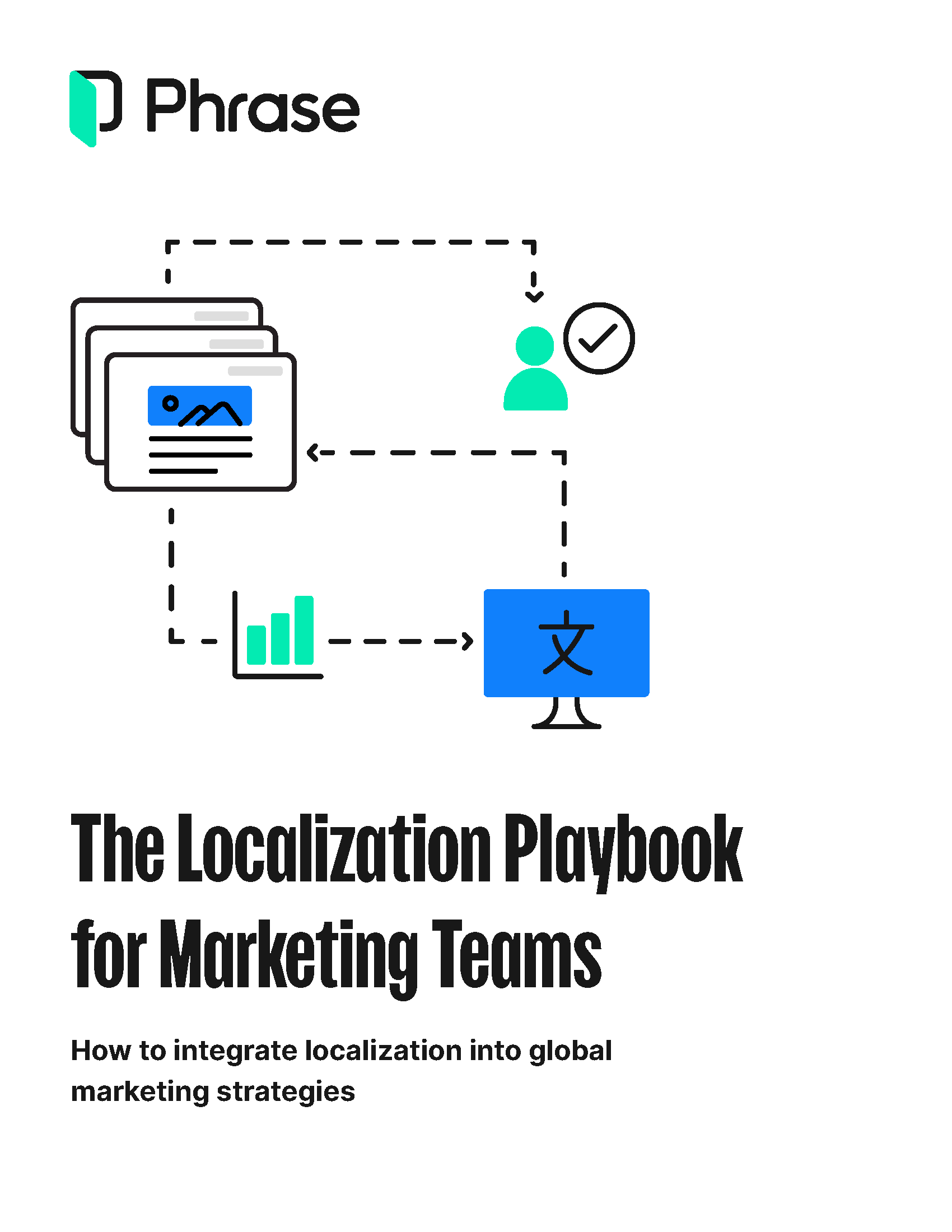
FREE DOWNLOAD
Make global marketing strategies work in local markets
Harness the power of localization to effectively connect with audiences worldwide and discover best practices for making your next global marketing endeavor a success.
What is a localization strategy?
A localization strategy is a plan that a company implements to adapt its products or services to the cultural differences, customer behaviors, and purchasing habits in different target markets.
Unlike a global standardization strategy, which aims to develop and apply uniform standards across multiple markets, the goal of a localization strategy is to frame the market positioning of a brand or product in a specific business geography.
From the markets and languages you want to target and the technology you use to the KPIs you measure—your localization strategy should be tailored to the needs of your business.
Why global businesses need a localization strategy
A strategy is to localization what a roadmap is to a journey. It’s a plan that outlines where you want to go, how you’re going to get there, what localization pain points you might experience along the way, and how you will solve them.
And just like with journeys, it’s not impossible to get to your destination without a plan—but you’re much more likely to encounter problems along the way and arrive at your destination later than you had hoped—if you arrive there at all.
Whether you’re just starting to expand your business internationally or you’ve been operating in multiple markets for years, a localization strategy should be considered a key component of your global business strategy from the start.
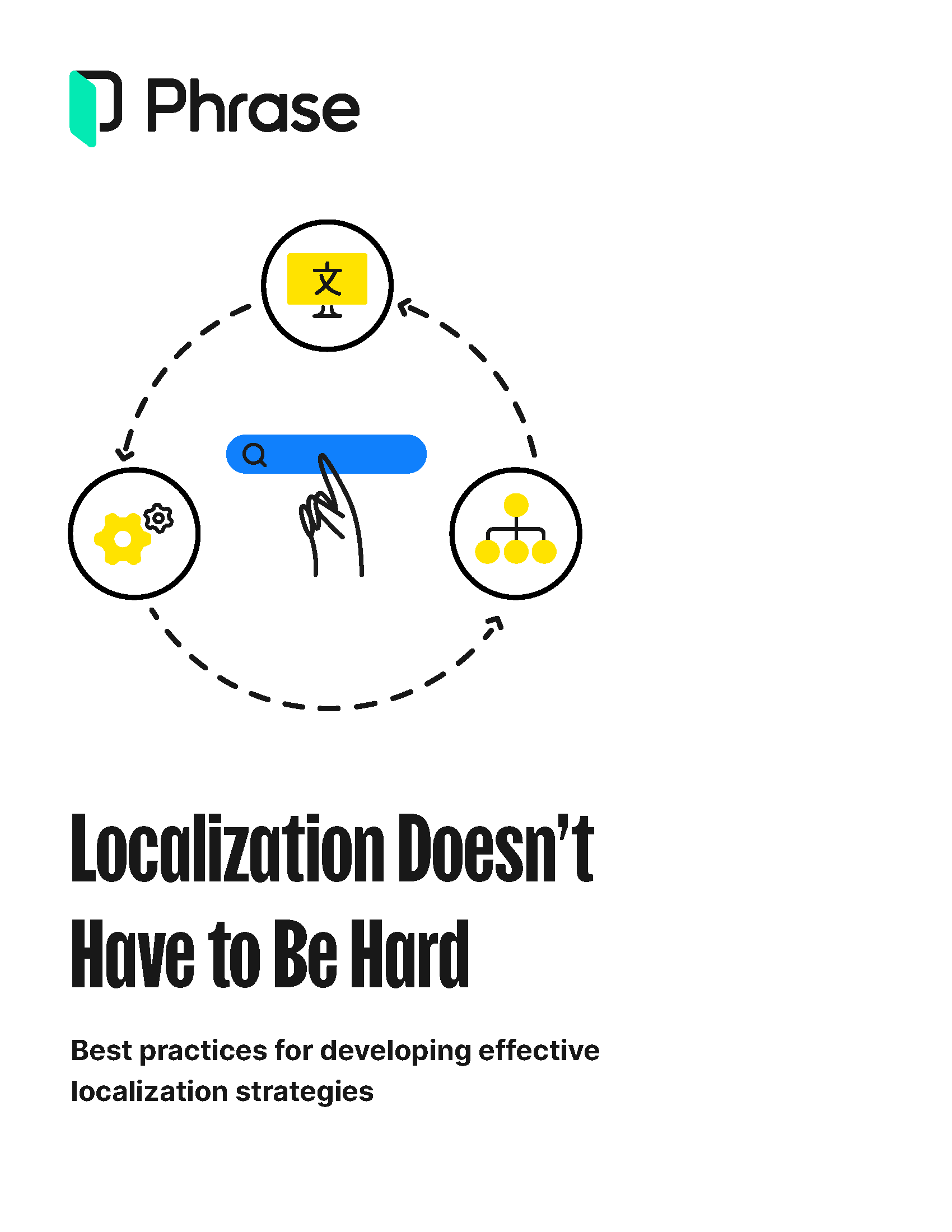
Free download
Best practices for developing effective localization strategies
Explore how to tackle localization management efficiently and engage customers across the globe in their native languages and local experiences.
The benefits of a localization strategy
Now that you’re aware of both the meaning and importance of a localization strategy, let’s have a closer look at some key benefits of a localization strategy.
Enables you to deliver an extraordinary customer experience
Customer experience is a fine art: It’s the result of many factors working together in harmony, from the usability of your product or service across cultures to the quality of your customer support. Localization is a critical piece of the puzzle, as it allows you to tailor your product or service to the specific needs and preferences of your target market.
As such, you shouldn’t treat localization as an afterthought—it should be an integral part of your customer experience strategy from day one. This means that your overall growth strategy and your localization strategy should be developed in tandem, with a clear understanding of how both will work together to achieve your business goals. Only then will you be able to ensure a consistent, cohesive customer experience across all markets.
Ensures fully adapted content for local markets
Half-hearted localization efforts will be evident to customers and can do more harm than good. Yet, piecemeal localization—where content is only partially translated or adapted, and the selection of what to localize is made on an ad-hoc basis—is a common trap that companies fall into. While often the result of time or budget constraints, this is frequently also the result of a lack of strategy.
A sound localization strategy will help you avoid this pitfall by ensuring that the selection of content for localization is based on concrete business goals and that the content localization process is managed effectively from start to finish. This will result in fully localized content that accurately reflects your brand identity and resonates with your target audience.
Saves you time and money
Developing a localization strategy may require an initial investment of time and resources, but it will save you money in the long run. This is because a well-thought-out plan will help you avoid common localization mistakes, such as handling multilingual content that may not bring an immediate return on investment, wasting time on manual processes, or avoiding bottlenecks that can slow down your growth.
In short, a localization strategy will help you use your resources more efficiently and get your product to market faster—2 essential ingredients for success in today’s competitive global landscape.
Provides a framework for measuring success
You can’t manage what you don’t measure. A localization strategy provides a framework for tracking the progress of your localization management and measuring the return on investment of your localization spend.
This data can then be used to get localization buy-in from stakeholders, adjust your localization budget to reduce costs, and allocate resources more effectively. In other words, it will inform future decision-making and help you optimize your localization efforts for maximum impact.
Helps you get it right the first time
There’s no room for trial and error when it comes to localization. In today’s global market, customers expect brands to understand their needs and provide a seamless experience—regardless of location. This means that you need to get it right the first time or risk losing customers to your competitors.
A localization strategy will help you understand the impact of cultural differences on customer behavior and identify any potential pain points in the customer journey. This knowledge can then be used to inform your localization decisions, ensuring that your content is culturally relevant and engaging for your target audience.
What makes a solid localization strategy?
The specific elements of a localization strategy may differ from one company to the next. Still, there are essential components that all effective localization strategies share:
- Framing localization within the company’s overall business strategy: Localization must be closely aligned with the company’s business goals. A clear understanding of your overall business growth strategy and how localization can help you realize it is essential for ensuring that your localization efforts are impactful.
- Being data-driven: Data is the foundation of any good localization strategy. Without data, you can’t determine which markets to enter, what content to localize, or how to measure the success of your localization efforts.
- Establishing clear objectives and KPIs: Your localization strategy should spell out exactly what you hope to achieve and how you plan to measure success. What are your goals? How will you know if you’ve achieved them? What KPIs will you use to track progress?
- Defining the target audience: Who is your target audience? What do they need from your content? A comprehensive localization strategy will take into account the cultural nuances that can impact how your target audience perceives and interacts with your content.
- Assigning roles and responsibilities: Who is responsible for localization within your company? Will you introduce the role of a localization manager who can lead the process? Who will create and review the translated content? A future-proof localization strategy will assign specific roles and responsibilities to different individuals or teams so that everyone knows their part in the process.
- Outlining the workflow: The best localization strategies provide a detailed roadmap for how the localization process will unfold every time you create new content. From ordering translations and creating a style guide or quality assurance (QA) checklist to reviewing the translated content and publishing it, a localization strategy spells out every step of your localization workflow so that there are no surprises.
- Establishing a budget: Localization can be costly, so it’s important to establish a budget upfront. A good localization strategy will consider all the potential costs—including translation, review, editing, and publishing—and allocate the budget accordingly.
- Setting timelines: Establishing timelines for each stage of the localization process ensures that content is published in a timely manner and that everyone on the localization team knows when they need to complete their tasks.
- Including strategy review and refinement procedures: Avoid the temptation to treat a localization strategy as something static—you should review and update localized content regularly to ensure that it remains relevant and effective. As your business grows and expands into new markets, your localization needs will change, so be sure to revisit your strategy as needed.
How to create a localization strategy
Once you know what goes into a good localization strategy, you’re ready to start creating your own. Building a localization strategy can vary between orhanizations, but it generally involves 3 stages:
- Analysis (resulting in diagnosis)
- Choice (resulting in guiding policy)
- Execution (resulting in coherent action)
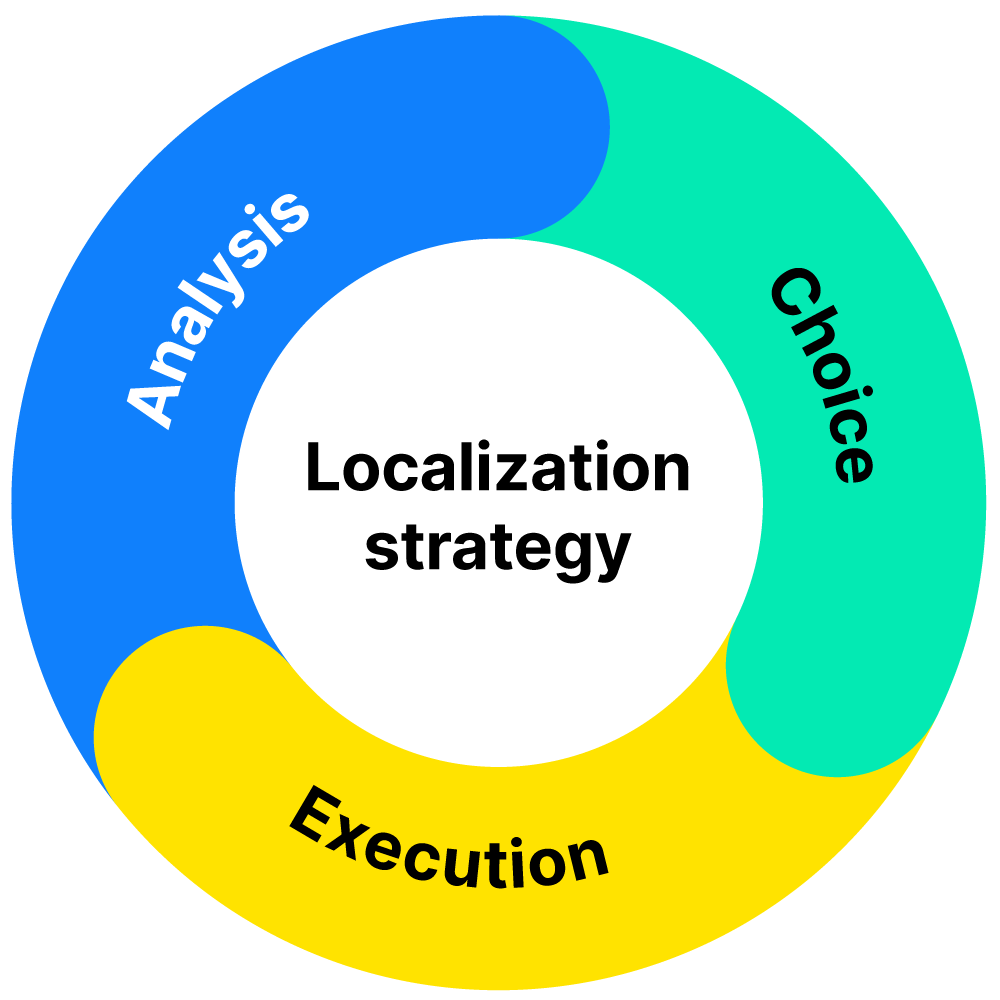
Stage 1: Analysis
This stage is all about understanding your company’s needs, goals, and objectives. Market research, target audience analysis, and competitor analysis are all important components of this stage. You will also need to take a close look at your resources, including your budget, timeline, and team.
The aim of this stage is to gather all the information you need to make informed decisions about localization. That’s why considering the business environment and establishing stakeholders’ expectations are also important parts of the analysis stage.
Stage 2: Choice
In this stage, you will use the information gathered in the analysis stage to select the best possible course of action. This stage will involve making decisions about:
- What localization technology to integrate into your digital ecosystem
- Which localization services to use for adapting your product or service
- Which language service providers to rely on when needed, etc.
Going back to the elements that make a solid localization strategy, this is also the stage where you will define your KPIs, assign roles and responsibilities, establish a budget, set timelines, and determine how you will review and update your strategy.
Stage 3: Execution
After you’ve gathered all the information and made all the necessary decisions, the execution stage puts your localization strategy into action. This stage will involve outlining the workflow—from content submission to translation delivery—and assigning roles and responsibilities.
During execution, the below steps need to occur:
- Internationalization: The process of making your content ready for localization. More specifically, internationalization (i18n) aims to ensure that your content is properly formatted, using the right character encoding, and avoiding hard-coded text in your product.
- Preparing assets for localization: The files that need to be translated—also known as localization files—will need gathering, exporting into code repositories, and organizing.
- Setting up the localization environment: Wherever you store your localization files—ideally, a translation management system—you will need to ensure that it’s configured correctly and that all the relevant stakeholders have access.
- Content localization and revision: The actual process of getting a team of linguists to translate your content, and the subsequent review and editing process.
- Deploying the localized content: Once your content is translated and edited, it needs to be published in the appropriate format—on your website, app, or another platform.
- Localization testing and QA: To ensure that your localized content is high-quality, you should give localization testing top priority. This stage can involve running automated tests, as well as manual linguistic and functional testing carried out by native speakers of the target language.
Regardless of how many steps you break your localization process into, it should ideally run in parallel with the product development process to enable uninterrupted delivery of multilingual content. In other words, linguists should be able to work with content as soon as developers make it available. This practice of integrating translation workflows into agile product development cycles is known as continuous localization.
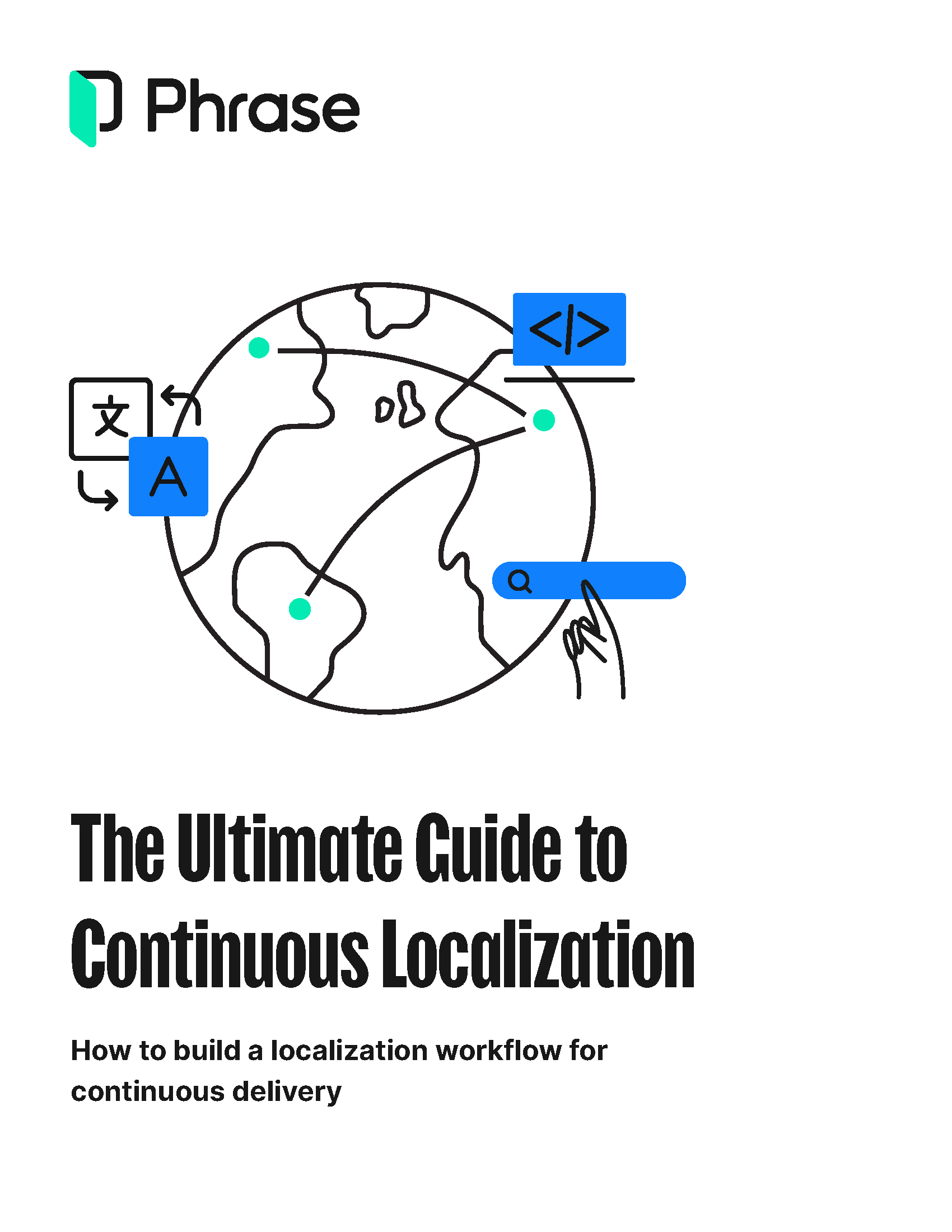
Free download
How to build a localization workflow for continuous delivery
Explore how to implement continuous localization into agile product development to optimize content quality, shorten the release cycle time, and reduce costs.
How to measure the effectiveness of a localization strategy
A data-driven approach is essential for effective localization, and one of the reasons data is crucial is that it enables you to measure the effectiveness of your localization strategy. Deciding what data to track is a crucial consideration.
Some companies are focused on quantitative measures, such as website traffic, while others prioritize more qualitative measures, like customer satisfaction or Net Promoter Scores (NPS).
The most important first step is to establish base values—that is, what your performance indicators looked like before you localized your content. Once you have those baseline values, you can measure the impact of localization by tracking changes over time.
For the purposes of a continuous evaluation of strategy effectiveness, make sure you have relevant goals and both measurable and achievable objectives. This typically means breaking your relevant KPIs down into smaller, manageable metrics that can be hit on a quarterly or even monthly basis.
Relevancy is critical here—you want to make sure you’re measuring the right things and not just things that are easy to measure. Moreover, for the evaluation to be current, the results must be available in a timely manner. That way, you can course-correct quickly if something isn’t working as planned, and adjust your strategy accordingly.
For example, your localization strategy can aim to increase app downloads in a certain region by 10% over 3 months from a present level of 100 downloads per day. This is achievable, relevant, and measurable simultaneously. If after 3 months you find that app downloads have only increased to 101 downloads per day, you know that something needs adjusting—maybe your objectives were too ambitious, the market isn’t ready, or there’s a problem with your localized content.
Here are some of the other most commonly used KPIs for measuring the success of a localization strategy:
Time KPIs
- Time from project kickoff to launch
- Time spent at each step of the localization workflow
- Percentage of on-time deliveries
- Number of missed deadlines
- Average turn-around-time (TAT)
- Idle time (e.g., between creation and assignment or between the delivery of a job and last status change)
- How quickly the content moves through the workflow
- Average editing time per 1K words per workflow step
- Throughput rate—how many words (or other units, e.g., strings) were translated over the number of working days
- Distribution of requests per PM, to make sure they are equally shared
Quality KPIs
- General pass/fail rate
- Average quality scoring for each provider/vendor per language, domain, etc.
- Amount of edits in the revision step
- Changes introduced between workflow steps
- Click-throughs on links
- Number of support requests or queries
- Number of end-user reports for errors or issues in translated content
- MT output quality
- Number of ignored QA warnings
Cost KPIs
- Money spent per business unit, provider, project, language, workflow step, etc.
- How much is paid in hours/words
- Amount of words translated per provider
- Average price per word
- Average price per hour
- Project management spending
- Budget compliance, i.e., spending vs budget
- Cost per metadata
- Most translated languages
- Top submitters
- Software costs
- Training costs
Business impact KPIs
- Overall revenue
- Monthly sales growth
- Average revenue per new customer
- New customers acquired
- Customer lifetime value
- Retention and churn rates
- International market growth rate
- Relative market share
- Customer satisfaction improvement over time
- Net promoter score (NPS)
- Customer effort score (CES)
- Customer satisfaction (CSAT)
- Sentiment analysis
Digital performance KPIs
- Organic traffic
- Number of unique visits
- Number of page views
- Average time on page
- Bounce rates on localized pages
- Site rankings (SEO)
- Social media engagement rate (number of interactions, shares per post, virality rate, audience growth rate, number of brand mentions, etc.)
- Conversion rate (sales, downloads, etc.)
- Click-through rate
- Number of transactions
- Number of new leads
Localization strategy examples to learn from
While there’s no one-size-fits-all solution to localization, there are certain best practices that all successful strategies have in common. To get an idea of what a good localization strategy may look like in action, let’s take a look at 3 localization examples that speak for themselves.
Airbnb’s localization strategy
The 2007 launch of Airbnb was nothing short of a revolution in the travel industry. The company has since grown to become one of the world’s most valuable multinational companies, with a valuation of over $62B.
A big part of Airbnb’s success is due to how it approached localization from the very beginning. The company realized early on that it would need to offer its platform in multiple languages to succeed in foreign markets. Salvatore Giammarresi, Head of Localization at Airbnb, said in an interview that Airbnb’s users, particularly those traveling cross-border, were by definition “on the move going through 2 or more locales—in many cases, there might also be a linguistic and cultural mismatch between host and guest.”
As a result, localization was essential to the company’s strategy from day one. Airbnb strives “to localize and internationalize everything that Airbnb creates, at scale, at a high quality, on time, and within budget” and “align [the localization] team with the values and business goals of the company.”
This has allowed Airbnb to scale its platform quickly and efficiently to new markets, without sacrificing quality or customer experience. Every aspect of the platform, from the user interface to customer support, is available in multiple languages—even the company’s logo changes to reflect local preferences (e.g., using a heart symbol instead of the letter A in countries where that would be more meaningful).
In addition to translating its platform, Airbnb also creates localized content to appeal to users in different markets. This includes things like blog posts about popular travel destinations, as well as user-generated content like reviews and descriptions of listings.
Netflix’s localization strategy
Netflix is another company that has localization at the heart of its business model. The streaming giant is available in 190 countries and offers its content in over 37 languages to over 200M people around the world.
Much like Airbnb, Netflix faced the challenge of how to offer a consistent user experience across multiple languages and cultures. With the goal of creating a streaming empire, Netflix couldn’t afford to let language barriers get in the way.
Originally founded as a DVD rental service, Netflix realized early on the potential of streaming video content online. In 2007, the company started offering its streaming services internationally with a limited selection of movies and TV shows.
What allowed Netflix to succeed where other companies had failed was its focus on localization. Some key components of Netflix’s localization strategy include:
- Not attempting to localize multiple regions at once: Having set up in 130 countries in the space of just 3 years, Netflix realized that it would be impossible to localize its content for every single market all at once. Instead, it took a more strategic approach, focusing on specific regions and expanding from there. This allows them to really focus their attention on creating a great user experience for each market without spreading themselves too thin.
- Using customer data to localize content: Netflix has a huge amount of data on its users, which it uses to improve the customer experience. This data is also used to inform localization decisions, such as which languages to offer content in and what type of content will be most popular in each market. This focus on data has allowed Netflix to create a localization strategy that is tailored to the needs of each individual market.
- Customizing the offer for each market: To appeal to local audiences, Netflix doesn’t just offer its content in different languages—it also tailors the content itself to reflect local preferences. The content you can watch on Netflix in different countries varies depending on what is popular in that market.
- Investing in customer experience: Another important part of Netflix’s localization strategy is its focus on customer experience. The company offers customer support in multiple languages and has country-specific social media accounts to engage with users around the world. It also ensures that the platform is easy to navigate, that users can find what they’re looking for, and that they have a positive experience using the service.
- Creating original content with a global appeal: In addition to its vast library of licensed content, Netflix has also invested heavily in creating its own original programming. This includes shows like Squid Game, a South Korean drama, Lupin, a French mystery thriller series, or La Casa de Papel, a Spanish heist drama. This local-to-global strategy has been successful in attracting new users and keeping existing ones engaged.
Starbucks’ localization strategy
Starbucks is another company that has successfully used localization to expand its reach. The coffee chain now has over 30K stores in more than 80 countries around the world.
When Starbucks first started expanding internationally, it faced the challenge of maintaining its brand identity while still appealing to local tastes. To do this, Starbucks adopted a localization strategy that involved:
- Dedicated design centers: Because Japan, New Zealand, and China all have very different design aesthetics and building needs, Starbucks has opened 18 design centers around the world to make sure that its stores fit in with local tastes. From community tables that foster conversation in cultures where that is the norm to ensuring that the biking community has ease of access in areas where that is popular, these design centers help Starbucks create a unique customer experience in each market.
- Tailoring the menu to local preferences: While Starbucks’ core offerings of coffee, tea, and pastries are available in all markets, the company also offers localized food and drink items that reflect local tastes and preferences. For example, halal food is available in stores in countries with large Muslim populations, and bubble tea is offered in Asian markets.
- Replicating the in-store experience across markets: One of the most important aspects of Starbucks’ localization strategy is its focus on replicating the in-store experience for customers no matter where they are in the world. This includes everything from the way stores are designed and decorated, to how employees are trained to interact with customers, to writing names on cups. By creating a consistent customer experience, Starbucks has been able to build a loyal following of customers around the world.
- Drink names in English (or Italian): For customers to feel that the in-store experience is consistent no matter where they are, Starbucks writes drink names in English (or Italian, when English has already adopted the Italian drink name). Cappuccino, espresso, flat white, and so on, are all written in English on Starbucks menus and blackboards no matter what country the customer is in. This small detail helps create a sense of familiarity for customers that makes them feel comfortable and welcome in any Starbucks store.
- A mixture of wholly-owned subsidiaries, joint ventures, and licensed stores: When Starbucks wants quick expansion in a particular country, it will open a licensed store that is managed by a local partner. However, in markets where it wants more control over the customer experience, it will open a wholly-owned subsidiary or joint venture. This tactic has allowed Starbucks to maintain a high level of control over its brand while still expanding rapidly into new markets.
Use localization as your springboard for global growth
This guide has walked you through the ins and outs of localization as a growth driver and how you can build an effective localization strategy to guide your business on its global journey. By setting achievable, relevant goals, measuring your progress against those goals, and understanding the importance of tailoring your content and message to local markets, you can make sure that your products and services are appealing to customers in every corner of the globe.

Unlock global business with the Phrase Localization Platform
Expand into new markets with all the tools you need in one technology suite for high-quality, fast, and scalable localization.





